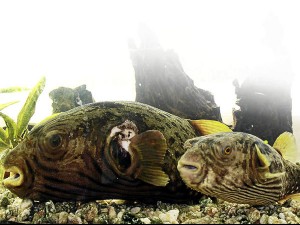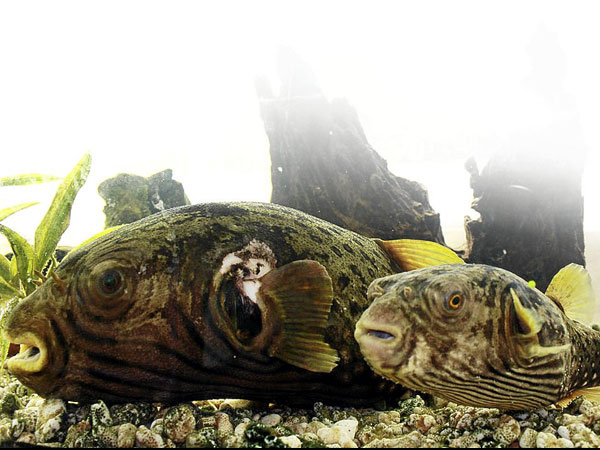
To the already long list of risky behavior patterns among Filipinos, add the propensity for eating food that can kill you.
I’m not talking about the slow death from arteriosclerosis as a result of feasting on cholesterol-laden favorites like sisig and lechon (although that’s on the list too), I’m talking about food that’s really to die for.
Each year, several cases are reported of people dying after eating butete, or puffer fish.
Last April, a family in northern Cebu was rushed to hospital after they consumed a meal that included butete. They complained of dizziness, vomiting and stomach pain. The father and his 8-year old son died, while the mother and another child had to be hospitalized.
The previous year, two fishermen died after eating butete, while six of their kin barely survived. The year before, several cases of fatalities and violent illness from eating butete were reported in one fishing town alone.
In many cases, the survivors said that they had eaten butete before with no ill effects.
Other residents in the areas where these fatalities occurred also insisted that although they knew the butete could be deadly, it could also be eaten safely if properly cleaned and cooked, and that those who died or fell ill must have prepared the fish improperly.
A few of the survivors said when they started feeling ill, they took sugar and coconut milk as an antidote.
Despite repeated warnings from health officials and information campaigns by fisheries personnel, butete is still routinely caught, cooked and eaten in some parts of the country, and people continue to die.
There’s even a current hit song, a Visayanized version of “Low,” titled “Butete” by DJ Oyee. The lyrics describe a birthday party in which the feast includes butete kinilaw, and its effects on the singer.
It is now available as a cellphone ringtone.
Complicating matters is the fact that there are over 20 species of puffer fish in Philippine waters, some of which are actually not poisonous. But even experts have a hard time telling the poisonous species from the harmless ones.
Puffer fish belong to the tetraodontidae family and are considered the second most poisonous vertebrate on the planet, next to South America’s Golden Dart Frog. The fish’s body contains tetrodotoxin, a lethal neurotoxin that is 100 times more deadly than potassium cyanide by weight. The fatal dose is a mere two milligrams. The toxin paralyzes nerves and muscles so that the victim is unable to breathe. The cause of death is respiratory failure. There is no known antidote. Victims have their stomachs pumped, and are fed activated charcoal to absorb the toxin. They are kept on life support until the poison wears off.
The toxin is concentrated in the skin, ovaries and other internal organs of the fish, while the flesh is relatively free of it, hence the temptation to play Russian roulette.
Puffer fish is known as fugu in Japanese, and is prized as a gourmet delicacy. Special fugu chefs go through years of rigorous training to learn how to prepare fugu safely, and must obtain a special license before they are allowed to serve fugu in restaurants.
The Japanese have also succeeded in raising non-poisonous fugu through aquaculture.
Still, there are occasional deaths reported in Japan from eating fugu, usually prepared at home.
On a side note, anthropologist Wade Davis theorized that puffer fish was one of main ingredients in “zombie powder” used by some Haitian voodoo practitioners. In his book “The Serpent and the Rainbow,” Davis speculated that zombies – the so-called walking dead – were simply victims of poisoning. Ingesting “zombie powder” resulted in a paralysis that could be mistaken for death. After burial, they could be dug up and “resurrected” as zombies.
Butete isn’t the only deadly dish in the Philippines, however.
Occasionally, there are news reports of people dying from eating cassava. The worst case in recent memory happened in 2005, when 27 children died and a hundred more were hospitalized after being served a cassava snack in a school in Bohol. The victims were rushed to hospital suffering from stomach pain, vomiting and diarrhea. Some died on the way.
Cassava roots contain a cyanogenetic glucoside that is broken down by digestive enzymes into its components, one of which is hydrocyanic acid. In order to be eaten safely, the cassava root must be peeled and thoroughly cooked.
There are two varieties of cassava common to the Philippines. White cassava has a high cyanide content, and is seldom eaten. Yellow cassava has a much lower concentration of cyanide and is the variety more commonly used in the familiar kakanin (native cake) routinely sold and consumed in the country.
White cassava was implicated in the Bohol incident. However, investigators also theorized that the food might have been contaminated by pesticides during its preparation, which would account for the violent reaction and high fatality rate.
Commenting on the tragedy, journalist Luis Teodoro wrote:“Cassava is a root crop widely consumed in the Philippines. It is used in a vast variety of cakes, snacks and desserts and grows wild in many places, being tough and drought-resistant. In a country where hunger is now a reality for many poor households, cassava is among those food crops that can make the crucial difference between starvation and survival. Cassava roots are excellent sources of energy, while the leaves, which are also cooked and eaten in many parts of the Philippines, contain vitamins A and C, calcium, protein and iron.
“While the bitter variety (white cassava) of the plant has larger concentrations of cyanide than the sweet variety (yellow cassava), Filipinos have known how to prepare cassava since it was first introduced into this country by the Americans, possibly by the Spaniards. That makes its poisoning anyone extremely rare.”
As if we didn’t have enough to worry about, now comes word that even the star fruit, more commonly known as balimbing, can be toxic to certain individuals. For the past decade or so, medical researchers have been releasing studies on the effects of balimbing on people with kidney disease.
Apparently, the fruit contains a neurotoxin that is filtered out of the body by healthy kidneys. People with impaired kidney function, however, especially those undergoing dialysis, are at much greater risk. In 2008, a number of fatalities attributed to balimbing were reported in Malaysia.
According to the literature, the victims suffered from “star fruit intoxication,” manifesting in hiccups, insomnia, vomiting, numbness, muscle twitching, weakness, confusion and convulsions. Most of the patients recovered, but a few fatalities were reported.
Food for thought.














































